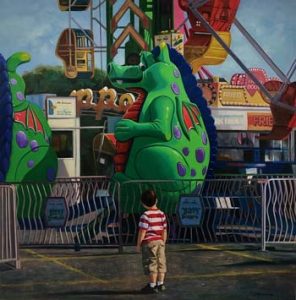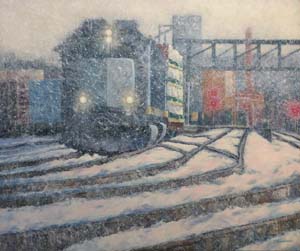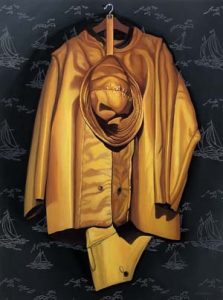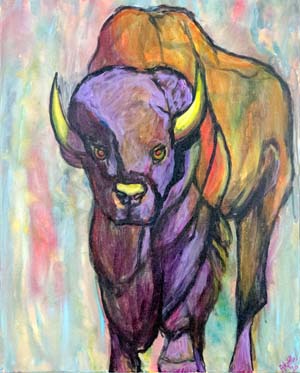March Artist of the Month – Meet Janet Montecalvo
March Artist of the Month

Meet Janet Montecalvo
Janet Montecalvo is a representational artist working in oils on wood panels or canvas. Her subject matter includes landscapes (often Boston), vintage signage and still life. She currently lives with her husband and two sons in Framingham and works at Tripp Street Studios.
 I was born in Boston and raised in Quincy, MA with three siblings, (including my twin sister). Much of my childhood was spent enjoying the outdoors, exploring the seashore of Wollaston beach and the city of Boston with cousins and grandparents. Lots of encouragement and art supplies furnished by my parents and grandparents fueled our creativity. Watching and following along with Captain Bob was must see television in my house. High school entries and wins at the Boston Globe Scholastic Art Awards led to my growing desire to attend college as an art major. I received a BA with distinction in the field art from Emmanuel College of Boston. After graduation I continued studying art and taking numerous commercial and fine art courses at the MFA, Art Institute and the New England School of Art and Design.
I was born in Boston and raised in Quincy, MA with three siblings, (including my twin sister). Much of my childhood was spent enjoying the outdoors, exploring the seashore of Wollaston beach and the city of Boston with cousins and grandparents. Lots of encouragement and art supplies furnished by my parents and grandparents fueled our creativity. Watching and following along with Captain Bob was must see television in my house. High school entries and wins at the Boston Globe Scholastic Art Awards led to my growing desire to attend college as an art major. I received a BA with distinction in the field art from Emmanuel College of Boston. After graduation I continued studying art and taking numerous commercial and fine art courses at the MFA, Art Institute and the New England School of Art and Design.
My career included a variety of disciplines in commercial art. Mural painting at Children’s Hospital during my undergrad and post graduate year led me to seek more instruction in paint application in public spaces. After a 3-year apprenticeship with The International Brotherhood of Sign Painters and Allied Trades, I became the first female licensed sign painter in Boston. In 1981 I began my own business providing lettering, graphic design and illustration services to retailers of Faneuil Hall Marketplace and Copley Place, Boston Symphony Hall, numerous advertising agencies, real estate developers and film & television productions. In 1985 I received an Emmy for graphic design contributions on the television movie,”I’ll be Home for Christmas”, starring Hal Holbrook and Courtney Cox.
Children’s book illustration became a major focus of mine during the next 15 plus years. My illustrations in the book,”Sofie and the City” were nominated for the Golden Kite Award (Best Picture Book Illustrations by peers) in 2007 and were presented in a solo exhibit at the Danforth Museum of Framingham, MA.

The different stages of my career are linked by a common thread-each position revealing my penchant for detailed work and honed my appreciation for design and craftsmanship. However, each phase left me yearning for the creativity that I found in my oil painting as an undergrad. My paintings have been described as “contemporary archeology”. I like to explore the spaces and physical objects associated with my life from mid twentieth century through the present. Specific details of the objects of the paintings evoke stories of what I and ordinary people do and what they hold dear. There is an “absence of presence”-that humans aren’t physically present, but evidence of their actions and interests is very much the subject. I try to invite the viewer up-close and personal into a world of simple pleasures from the past and present.
My landscape paintings usually are cityscapes and often are of Boston locations or New England seascapes. Occasionally, I will sign up for a plein aire workshop to loosen up or to just be around other painters. When painting in the studio I sometimes use sketches, but very often need to rely on my photographs. Most often I paint directly onto the panel and layer paint and correct proportions as the painting progresses. Other times, I make a full-size drawing or enlargement and transfer it to the panel to begin the painting process- a trick I learned in the sign business. It can be a real time saver.

My still life painting is usually set up in my studio and painted directly. I also use the help of photos. Sometimes I’ll refer to the worldwide web for examples of vintage wallpaper for inspiration and then create my own design for a backdrop in one of my still life paintings. Whatever works!…Subject matter varies but often has something vintage like a tin toy or pop element.
I paint because art has always been a part of my life. It’s therapeutic for me. When I don’t do it, I feel it. It can be very challenging. It’s difficult and rewarding at different times and when you’re really lucky it all happens at the same time! Sometimes when people say things like “you are so talented or your painting is a gift”, I thank them and I think to myself that it is a skill and that the gift is “the desire”.

Follow Janet on IG@ Janet_Montecalvo_Art







 Meet Felicia Tuttle
Meet Felicia Tuttle  I’m a self-taught artist and have been drawing since I was a little girl. I’ve always had a knack for it. I can remember getting in trouble in Middle School for doodling in Social Studies class. I knew then that I wanted to major in Art but life had other plans for me and so I got a Business Degree. That never stopped me from creating art. I always found a way to do it whether it was sketching in class or anywhere on campus. After graduation, I worked in the Information Technology industry, got married and found my 1st studio at Fountain Street Studios in Framingham, while raising 2 boys.
I’m a self-taught artist and have been drawing since I was a little girl. I’ve always had a knack for it. I can remember getting in trouble in Middle School for doodling in Social Studies class. I knew then that I wanted to major in Art but life had other plans for me and so I got a Business Degree. That never stopped me from creating art. I always found a way to do it whether it was sketching in class or anywhere on campus. After graduation, I worked in the Information Technology industry, got married and found my 1st studio at Fountain Street Studios in Framingham, while raising 2 boys. 



















 The Wellesley Society of Artists would like to recognize the following people, organizations and businesses that have helped us promote the visual arts and artists in our community this past year. They have all provided immeasurable support and we owe them a debt of gratitude for helping us to make art a part of our lives. Their help and generosity ensures that the arts continue to bring us together.
The Wellesley Society of Artists would like to recognize the following people, organizations and businesses that have helped us promote the visual arts and artists in our community this past year. They have all provided immeasurable support and we owe them a debt of gratitude for helping us to make art a part of our lives. Their help and generosity ensures that the arts continue to bring us together.